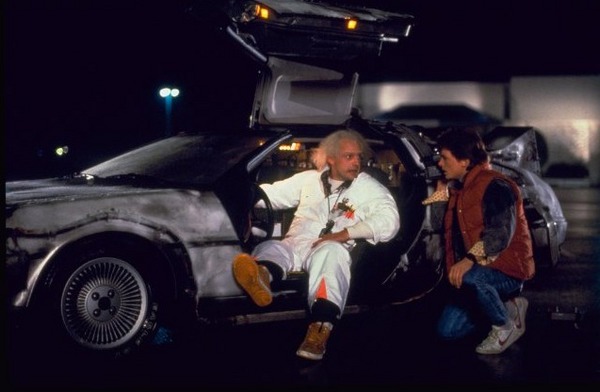Science Fiction or Fact: Is Time Travel Possible?

In this weekly series, Life's Little Mysteries rates the plausibility of popular science fiction concepts.
In the first "Back to the Future" movie, all it took to travel through time was 1.21 gigawatts and a flux capacitor (packed into a DeLorean sports car for style points). Despite centuries of dreams and decades of bona fide research, flux capacitors remain beyond our grasp, as do any other time travel-enabling devices.
From a pure physics point of view, travel into the future is not at all impossible and in fact happens all the . . . time. With all due respect to Doc Brown, however, backward time travel stacks up as a much tougher proposition.
"We can travel at different rates to the future," said Seth Lloyd, a professor of quantum mechanical engineering at the Massachusetts Institute of Technology. "To go into the past and mess around with it, that's more controversial."
My watch or yours?
For a real, everyday example of time travel, consider the satellites of the Global Positioning System. Were it not for built-in calibrations, the GPS atomic clocks would gain 38 microseconds over terrestrial timepieces every day, throwing off their location accuracy by several miles. "Clocks on Earth tick a tiny bit slower than satellites out in space," said Lloyd.
The reason: time dilation, as described by Einstein's two theories of relativity. According to the special theory, the faster an object moves relative to another object, the slower it experiences time. For GPS satellites zooming around Earth at nearly 9,000 mph (14,000 kph), this effect cuts seven microseconds off their clocks daily (relative to clocks on Earth).
Get the world’s most fascinating discoveries delivered straight to your inbox.
The second effect, explained by the general theory of relativity, involves gravity. Clocks closer to the center of a gravitational mass, such as Earth, tick more slowly than those farther away. GPS satellites orbit 12,500 miles (20,100 km) above the ground, and as a result have 45 microseconds tacked onto their clocks per day. The net result of the two relativistic phenomena is 38 microseconds, which engineers have accounted for with GPS technology.
Future, here we come
Both of these time dilation pathways — motion through space or a strong gravity well — permit time travel into the future.
A popular imagining of the first scenario involves astronauts cruising aboard a rocket ship at extremely high speed to a distant star. Upon their return, the ship's occupants will have aged mere years while centuries have passed on Earth. (An unintended version of this situation befalls Charlton Heston and his crew in the original 1968 movie "Planet of the Apes.")
Pulling off such a feat is really only a matter of investment, technology and will. "Doing 'century hopping' via relativity will require some engineering solutions to things like building rocket engines with enough fuel supplies for very prolonged trips," said Jeff Tollaksen, a professor of physics at Chapman University in Orange, Calif. [7 Everyday Things That Happen Strangely in Space]
Going to a distant star and back would not even be necessary — all that is required is motion. The time-traveling effect would be achieved by simply getting whirled in a giant centrifuge at near-light speeds, Tollaksen said (though it would kill whoever attempted it).
The second, gravity-based scenario poses similar lethality, at least for someone wanting an appreciable difference in his relative time frame. If you stood on a neutron star for a few years, a decade would elapse on Earth. Of course, you would not survive the supermassive star's crushing, rending gravity, making this approach truly a "Rip" van Winkle method.
Yesteryears
What of diving into the past? According to general relativity, a rotating black hole can warp space-time, forming paths to previous moments. "You have these so-called timelike curves that you could follow that would take you back to your past," said Lloyd. [What Would It Be Like to Travel Faster than the Speed of Light?]
Quantum mechanics has opened up strange avenues as well. Experiments have shown that measuring a particle property at an initial and end stage can modify its middle value, but only if the last measurement takes place. Such clues toward a possible "backwards causality" continue to be investigated.
A major showstopper for traveling back in time, however, is common sense. A classic example is the grandfather paradox, in which a time traveler goes into the past and murders his grandfather, thus preventing the time traveler from ever being born.
Yet there might be ways around this mind-bender. Lloyd has conducted quantum mechanical experiments in the last few years that suggest timelines remain self-consistent. The tests served as "the moral equivalent of sending a photon a few billionths of a second backwards in time and having it try to kill its former self," Lloyd said.
In Lloyd's experiment, as photons got ever closer to interfering with themselves, the probability of the experiment succeeding grew ever lower. "Our theory has an automatic censorship of things which are completely inconsistent," said Lloyd. "When you go back [in time], no matter how hard you try, you cannot change the thing you try to change."
In theory, then, Grandpa lives, no matter what.
Space-time busters?
A couple of other domains offer hope for would-be time travelers. Moving faster than light — the universal reference point — would do the trick, hence the excitement over last year's finding in Europe of superluminal neutrinos, a seemingly impossible finding that has been widely faulted.
Wormholes — theoretical "tunnels" through space-time — also could burrow into the past or future just as they might connect different regions in the cosmos.
Neither of these alternatives seems particularly likely. As much as many of us might hate to admit it, the past, with all of its mistakes, could remain sealed off from our efforts to redo it.
"Even if the laws of physics allowed visiting the past," Lloyd said, "it is not clear how it might actually happen in our universe."
Plausibility score: A one-way ticket to the future requires a hefty budget and a heck of a lot of engineering know-how. Voyaging into the past, however, looks to be near impossible, so we give time travel two out of four Rocketboys.
This story was provided by Life's Little Mysteries, a sister site to LiveScience.





